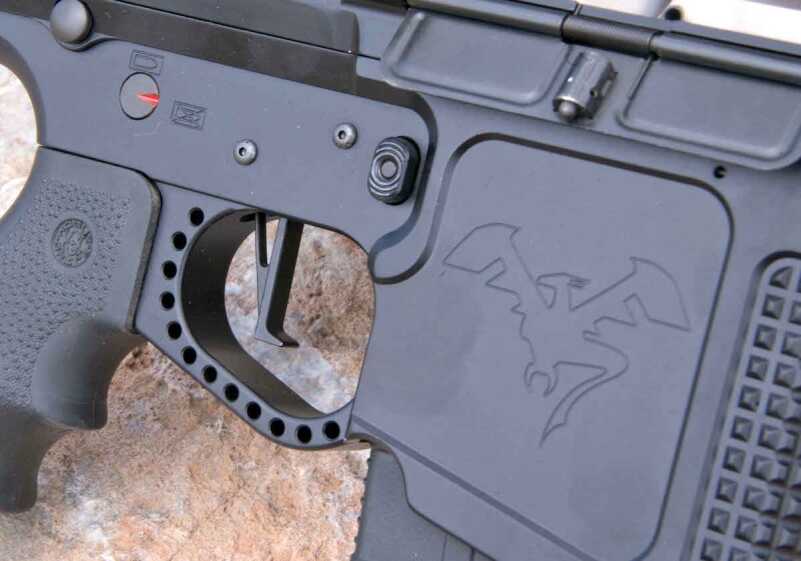
The STAR10-B from DoubleStar Corp. gives shooters custom-grade features like a CMC trigger and enhanced magwell and triggerguard at a production rifle price point.
To learn more, visit https://star15.com.
DoubleStar is a firearms company born of the AR accessory market. After years making parts for “black rifles” as J&T Distributing, Teresa and Jesse Starnes started DoubleStar Corporation (DSC). For years they provided parts and accessories for the “do-it-yourself” AR market, stocking items from most every major manufacturer. Their barrels have long been renowned for their performance, along with quality kits for those who wanted to build their own rifles. No other modern rifle lends itself to customization like the AR, and J&T Distributing was one of the first to truly service that market with very high-quality parts.

From its ACE Stocks Hammer buttstock to the Bullseye Muzzle Brake, the STAR10-B is packed with custom-grade features.
As rifles built using their parts continued to excel, customers asked for complete builds using their parts and accessories. Based on this demand DSC was born, providing a complete line of rifles (and now pistols). With over two decades supplying the parts to build AR rifles, they had the experience to go with the capability and expertise needed. It allowed them to build rifles to high standards that meet the needs of just about any shooter. Based in Winchester, Kentucky, DSC uses only U.S.-made parts. Each rifle is assembled with great attention to detail and above all pride in the final product. And, each rifle is test fired prior to packaging and delivery to dealers and customers.

The STAR10-B is built on a solid foundation of selecting the right parts, which comes from the company’s background with J&T Distributing.
DoubleStar’s Stable
DoubleStar offers a number of rifles in varying calibers. Its 300 Blackout is a straightforward and capable AR using a new and increasingly popular caliber. Designed with the competitor in mind, the 3GR (3-Gun Rifle) uses components proven in competition like a stainless match grade barrel, Bullseye Muzzle Brake and ACE ARFX stock. For those looking for a self-defense or duty carbine, the ARC meets that need with its 16-inch nitride-coated barrel, ACE SOCOM stock and folding sights. Looking for light weight? Then the Constant Carry (C3) carbine is perfect, weighing in at a mere 5.75 pounds. If you want just the basics, the DS4 is the ticket. It is a capable representation of the original M4 Carbine-style configuration, with quality parts and a reasonable price tag. If precision is in order using the 5.56mm cartridge, there is the MDM (Modern Designated Marksman) and Midnight Dragon. If you are looking for a AR pistol, the Mini Dragon is available in either 300 Blackout or 5.56mm in various barrel lengths. The company also offers a Patrol Carbine designed with the officer in mind and the StarCar, a basic AR that keeps things simple and affordable.
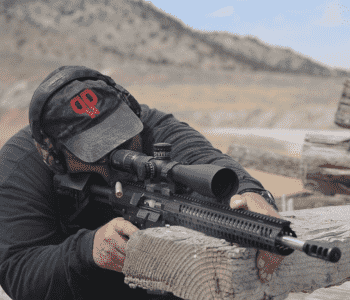
The author found that the magwell could act as an effective brace for improvised shooting positions.
SPECS
- Chambering: .308/7.62x51mm
- Barrel: 18 inches
- OA Length: 41 inches
- Weight: 9.8 pounds
- Sights: Continuous top rail
- Stock: ACE Hammer
- Action: Direct gas impingement
- Finish: Matte black
- Capacity: 20+1
- MSRP: $2,566
How for those that want to step up in power? Introduced in 2015, the STAR10-B is a .308/7.62x51mm rifle purpose built for accuracy, hard use and reliability. Starting with billet upper and lower receivers machined from 7075-T6 aluminum, the STAR10-B uses quality parts and innovative build features. The upper receiver houses an 18-inch Wilson air-gauged stainless steel barrel using a 1:11.25 twist rate. It’s capped with a Bullseye Muzzle Brake designed for ultimate muzzle control. Fluted and free floated, the barrel uses a rifle-length direct impingement gas system with a low-profile gas block. Samson’s 15-inch Evolution handguard covers the barrel, providing ample mounting positions for rails of various lengths. The bolt carrier has been NIB-X (Nickel Boron) coated for ease of cleaning and enhanced operation under adverse conditions. BCM’s Gunfighter 7.62 charging handle rounds out the package.

The length of the magwell provides a lot of extra handhold room, but can make inserting mags shorter than 20 and 30 rounders a little complicated.
Nestled in the lower receiver is a CMC flat trigger. Self-contained, it is a drop-in trigger pack. This trigger is a single-stage with the usual quality and feel expected from CMC triggers. An Ergo Grip provides control along with an oversized triggerguard. Unique to the design is an extended/enhanced magwell. Longer than a standard magwell, it is heavily checkered for use against barricades, or for a strong hand hold when necessary. A lip at the bottom locks the lower into place on obstacles. ACE’s Hammer buttstock and seven-position buffer tube are installed, one of the strongest on the market. Both are machined from heat-treated aircraft aluminum. Five spring-loaded ball bearings make operation smooth, while etching on the tube provides easily visible position markings. Locking in place, the adjustable cheekpiece can be installed in three different positions to facilitate scope use and allow operation of the charging handle. Angled at the bottom, the stock provides solid purchase for bags or packs for rear support. Slings are accommodated with a top-mounted slot at the rear of the stock with a single QD cup. My test rifle shipped in a box with a plastic case and two 30-round PMAGS.
Eye On The Target
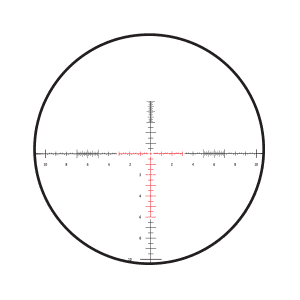
The Burris SCR Mil Lined reticle has a vertical line with 20 mils graduated in half mil increments below the horizontal line. Image courtesy of Burris Optics.
Sighting was accomplished with a Burris XTR II 5-25X FFP scope using their SCR Mil Lined reticle. It was mounted in a Larue Tactical PSR20 mount. Clarity on the glass is excellent and the reticle is comparable to any simple Mil lined reticle on the market. The vertical line has 20 mils graduated in half mil increments below the horizontal line. There are five mils above with the last two graduated in .10 mils. Extending on either side are 10 mils graduated in .2 of a mile for the first five where another .10 mils section sits for ranging calculation. The center section is lighted for three mils on either side and six mils below the center line. Dialed up to 15 power, there were 11 mils available for holds with the entire horizontal line visible. Knobs are tactile with audible clicks at .10 mils per click and 10 mils per revolution. Numbers are easy to read. The XTR uses a zero stop that is easily adjusted. Loosen the screws, slip the knobs to zero and press firmly and re-tighten. Parallax adjustment sits on the right along with lighted reticle activation. There are 11 settings with “battery saver” steps in between each setting and a hard “off” setting at both ends. Scope covers that flip flat against the scope when open are included.
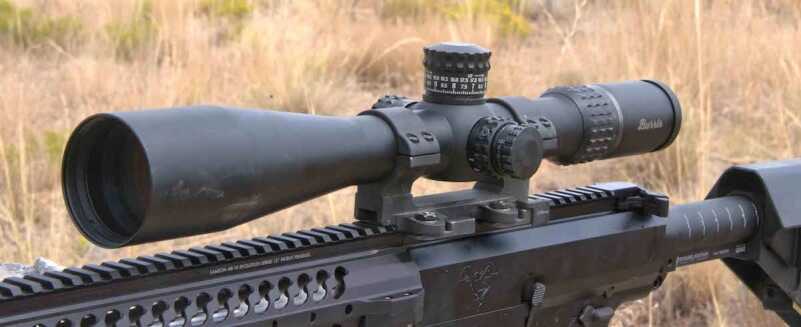
The author equipped the rifle with a Burris XTR II 5-25X FFP scope mounted in a Larue Tactical PSR20 mount.
Range Time

The author’s best group came from Sig Sauer’s 168-grain OTM Match Grade Rifle load measuring just outside .50 inches.
Given the Wilson air-gauged barrel, better than average accuracy was expected and delivered. Most groups were under an inch with my best coming from Sig Sauer’s 168-grain OTM Match Grade Rifle measuring just outside .5 inches. It was easily the most consistent in this rifle. Rapid-fire strings with other ammunition resulted in some vertical stringing, possibly due to heat, but the Sig Sauer was very consistent. At 300 yards it grouped right at 2.5 inches, the best of the ammunition tested. Remington’s 165-grain Premier Accutip was also very accurate, although it always seemed to result in a fifth-round flyer, although it was still under an inch. Not sure if that was me on that day. Accuracy testing with Aguila’s 150-grain FMJ was consistent at between an inch and an inch and half with groups in the 3-inch range at 300 yards. It had no issues ringing the 12-inch steel at 500 and 650 yards.
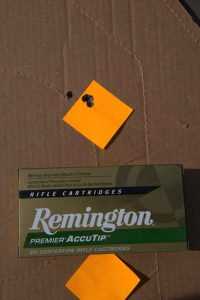
Remington’s 165-grain Premier AccuTip was also very accurate, although it always seemed to result in a fifth round flyer.
Recoil with the STAR10-B was very manageable, mostly due to the Bullseye Muzzle Brake. Blast was manageable for the shooter but pretty oppressive if you are next to it, but that’s life with a muzzle brake. It provides excellent muzzle control, with minimal rise and very little side-to-side movement. Little blast was extended either up or down, so shooting from prone was not unpleasant. Shooting in close quarters was, as usual with a brake, distracting at best.
Brass ejection was consistent with no failures to eject using several types of ammunition. Along with accuracy testing, several magazine fulls were fired using my “bucket of ammo” consisting of various .308 ammunition separated by bullet weight. Most is FMJ, brands vary along with velocity, but it is all factory new. Shooting steel at 400 yards, it was consistent with all bullet weights from 147 to 175 grains. In most cases the 1:11.25 twist rate works best with 155- to 168-grain bullets, and the STAR10-B followed the model.
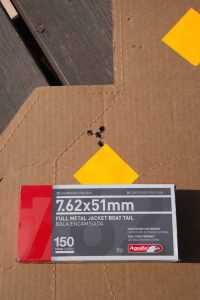
Accuracy testing with Aguilas’s 150-grain FMJ was consistent at between an inch and an inch and half.
Several magazines were used including Gen2 and Gen3 PMAGS in 20- and 30-round capacities. DPMS magazines were tested in 10- and 20-round versions along with Brownells’ Mil-Spec 20 rounder’s, Lancer Systems, and Larue Tactical versions. All of them inserted and worked fine, although the 10-round DPMS magazine is completely covered by the magwell. They eject just fine, but you will not be able to grasp them at all; in fact you need to push them in place from the bottom. Not an issue for most, but if your world limits you to ten you are going to want a pinned long magazine. All others cycled well, inserted easily and ejected properly. My Larue magazines were the tightest fit, followed by the Lancers. The PMAGS were the loosest.
As one might expect, the Hammer stock is very solid, locked into place nicely, was easy to adjust and stayed in place. The cheekpiece was easy to adjust and could be reversed if needed. Tightening the screws on either side kept it in place throughout testing. Just remember, you cannot clear the charging handle unless it is fully extended. Threaded holes sit along the stock that could be used for sling studs or other threaded additions. ACE also sells buttpads of various lengths.

DSC’a extended magwell proved solid while working on and around the bench, on barricades and a stack of railroad ties on the range. It was possible to really lock it down, especially on wide and flat surfaces. Heavy checkering on the front digs into wood or similar surfaces. Placed on top of a bag or pack, it sits solidly as well. If you find yourself grasping the front of the magwell for some reason, it provides a nice hand hold. Not the best hold for stability, but it’s all you have at times and this makes for a solid purchase. Put on some gloves and it really locks into place.
Final Thoughts

ACE’s Hammer buttstock and seven-position buffer tube are installed. Five spring-loaded ball bearings make operation of it smooth.
Using CMC’s trigger adds to the capability of the rifle. My preference remains a two stage, and they offer one if so desired. This trigger was predictable and reliable with no light primer strikes experienced including on some mil-spec primers. Nor did it come loose during testing.
During ten-round, rapid-fire strings, especially at range, the barrel did get hot pretty quickly, resulting in some vertical dispersion at range. I found myself changing my hold on target at 500 yards to stay on steel for the last few rounds. It did not present itself during group shooting where time between shots was more normal.
Weight and balance on the STAR10-B is excellent, with the balance point right at the front of the magwell. Fluting the barrel keeps things light and the contour is not too large. It was pleasant to work with around the barricades, outside the muzzle blast. In my experience 18 inches is about right if you are looking for close quarters work with the .308/7.62x51mm, and this rifle was no exception.
[one_half]

Samson’s 15-inch Evolution handguard covers the barrel, providing ample mounting positions for rails of various lengths.
[/one_half]
[one_half_last]
[/one_half_last]
All in all, the STAR10-B was very accurate, reliable and handy to run on the range and in and around barricades and other obstacles. Priced at $2,566, it is about in the middle for .308 rifles using the AR design, especially given the quality of the barrel and overall design. It will suit most anything you would use a .308 for and is built to last. If you are looking for a semi-auto .308, then make sure you add this one to your list.
To learn more, visit https://star15.com.

